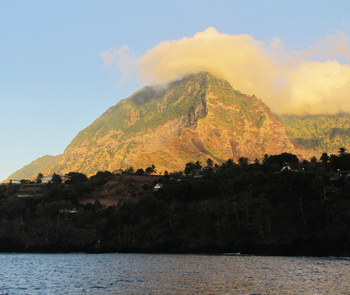
Hiva Oa
Marquesas Islands
May 2010
Part Two
| |
| HOME |
| About Tenaya |
| About Us |
| Latest Update |
| Logs from Current Year |
| Logs from Previous Years |
| Katie's View |
| Route Map |
| Links |
| Contact Us |
![]()
May 25, 2010
Steep, verdant, tightly folded mountains edged with precipitous, volcanic rock bands and often topped with oddly shaped formations rise out of the Pacific to create the gorgeous Marquesas Islands. The young, rugged, islands, six large and six small, are the northern most territory of French Polynesia.
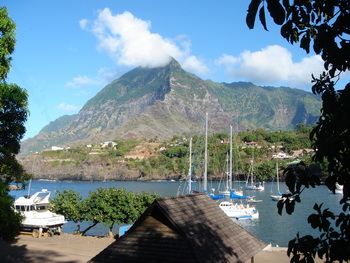
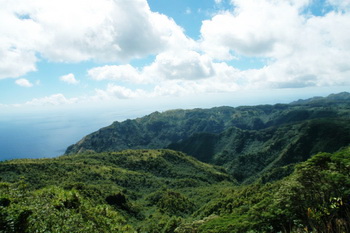
Easy to navigate, they are not bound by coral reefs like many islands in the South Pacific so are a perfect place to make landfall after a long passage. Interestingly, the distance we traveled from the Galapagos, approximately 3,000 miles, is about the same distance a sailing yacht would travel directly from San Diego.
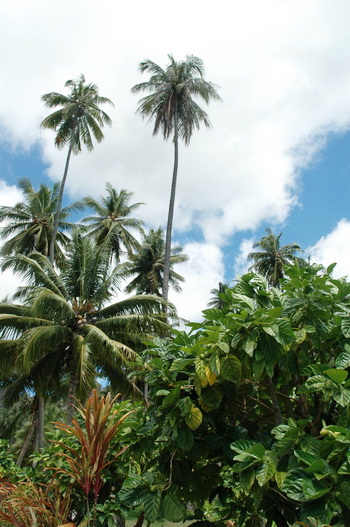
Exotic and peaceful, Hiva Oa is one of the larger islands and Atuona, where we've dropped anchor, is the second largest town in the Marquesas, which isn't really saying much. The water in the crowded harbor is brown and not ideal for swimming but the scenery is nice with mountains rising on three sides. There is wifi, a laundry service and a man sells fresh fruit from his truck each morning at 8:00. Perfect!
Locals fish for hours along the long concrete dock built for the two large ships that bring people and cargo to this remote place. The people are generally on the large side, quiet, and seem to be in no hurry at all. Nearly everyone drives 4-wheel drive trucks, many of them quite new.
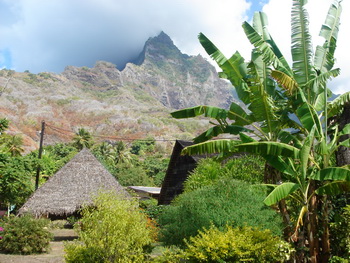
French artist, Paul Gaugin, found Polynesia irresistible and made his home at Atuona when he was no longer welcomed in France. He had a fondness for young girls that was bothersome to polite society so he returned to the island in hopes of a more simple and savage-like lifestyle. He died here and is buried in the cemetery above town. Not until after his death did his art become valuable.
Belgian songwriter, Jacques Brel, was also enamored with the island and was building a house overlooking the sea near Atuona when he died. He is buried here as well. A celebrity in Europe, he found the ideal paradiscal getaway on Hiva Oa.
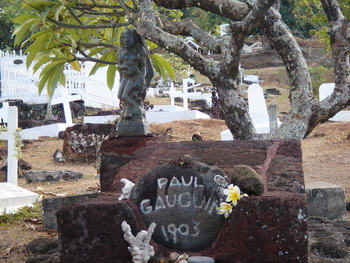
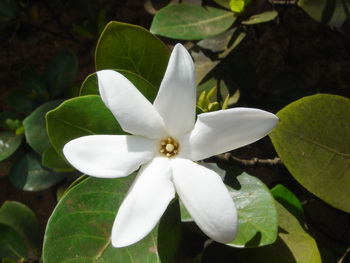
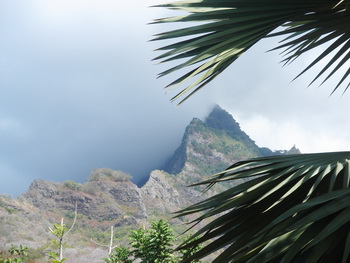
The majestic, heavily wooded interior beckons to be explored. We took a tour to the Puamau Archeological Site on the other side of the island to get a glimpse of ancient Hiva Oa and a feel for the wild, mostly uncultivated landscape. Lush vegetation covers jagged mountains while breadfruit, grapefruit, mango and many other trees flourish in the fertile valleys and large open spaces of the plateau.
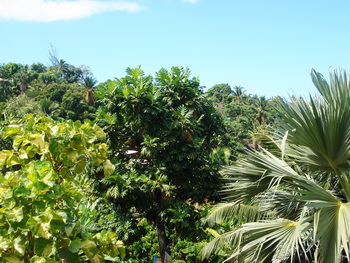
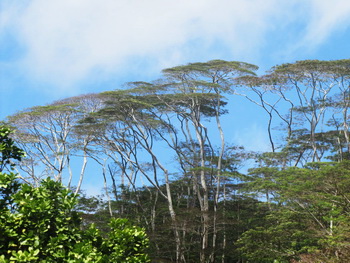
Hiva Oa is 23 miles long, 10 miles wide and reaches elevations of 3000 feet. Its coastline is scalloped with bays of varying sizes, most of which are flanked by steep hills and have black or white sandy beaches. Narrow paved and dirt roads twist and turn up and down the slopes at frightening angles.
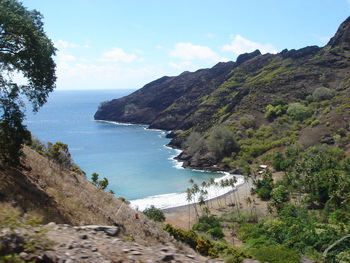
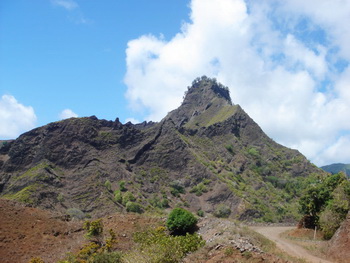
We climbed in the back of our guide Ozanne's pick-up and bounced across the island stopping several times to take pictures of the gorgeous scenery.
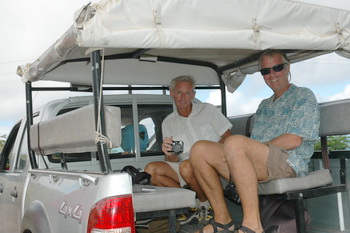
Ozanne turned down a narrow dirt road overhung with palms and lined with banana plants. Passing beneath a citrus tree with enormous yellow globes hanging from its branches, we wondered what they were. Pamplemousse ... grapefruit ... huge grapefruit. We bought eight which weighed close to twenty pounds! A small bunch of tasty, sweet bananas cost three dollars and we'll have plenty to eat and freeze for bread.
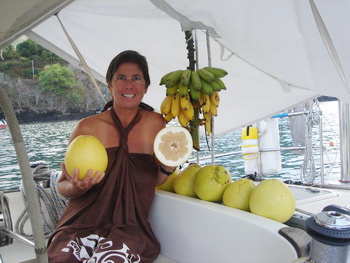
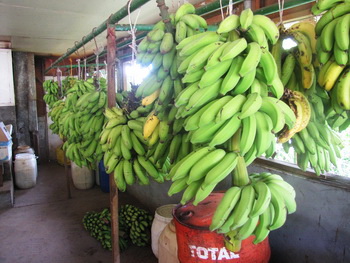
Atuona is a small town with a main street about a mile long and a few side streets that lead up the mountain to residential plots. Several small supermarkets, all of which sell fresh baguettes but limited produce, can be found. In the mornings French pastries are available, a nice slice of France, but there is no hope of getting a good cup of coffee, only Nescafe.
A few artisan shops sell wood carvings, jewelry, pareos and tapa which is a papery cloth made from the wood of breadfruit or banyan trees. These are painted with tiki, geometric or animal shapes. No internet cafes exist but desperate cruisers found unsecured wifi from a nearby house and browse the web under the shade of this expansive tree.
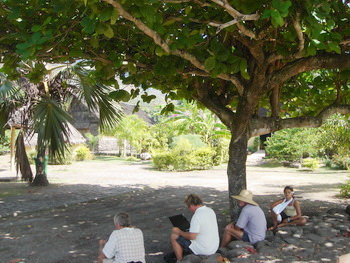
.
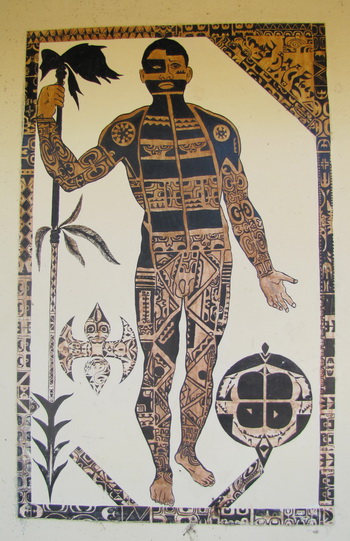
Many believe that tattooing originated in Southeast Asia and spread when people settled the Pacific islands. The Polynesian style developed using parallel lies, chevrons, circles, triangles, sharks teeth and other geometric shapes.
Tribes had specific tattoos and boys received partial tattoos while young which were expanded when they reached a certain age. Tattoos could cover a man's entire body including face and scalp. Or, tattoos could cover only one side of the body, splitting between the eyes, down the nose, past the middle of the chin, along the center of the torso and down one leg to the foot.
Girls and women had tattoos as well. They still do, though not was many as men. Women's tattoos are usually on their hands, arms, lower back and feet and are some sort of geometric shape. There seems to be a cultural revival as more young men and women are being tattooed now than in past decades.
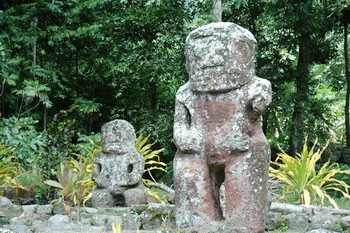
The Puamau Archeological site is a magical place beneath towering peaks not far from the sea. Birds sing from the branches of the dense foliage and mangos drop from a giant tree overloaded with the succulent fruit.
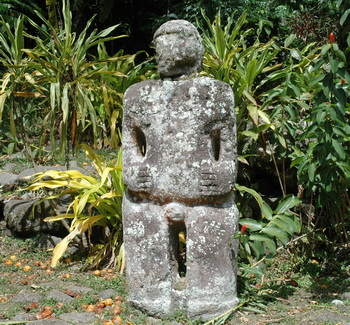
Tiki have been claimed by Tahiti and other Polynesian islands but they are actually Marquesan. These tiki are over 2000 years old. It is believed the great stone statues on Easter Island were carved by migrating Marquesans and one group of seven are called Freres Marquisians, Marquesan brothers.
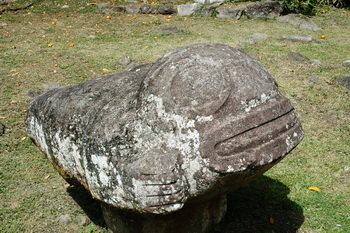
A priestess named Tau'a Pepe died during childbirth. Her son survived and her husband carved this statue depicting the mournful event.
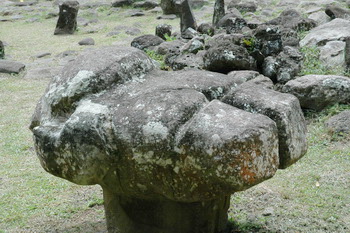
Taka'i'i is the largest stone statue west of Easter Island and is found at Puamau. The site also contains several platforms made of stones that were used for various ceremonial purposes as well as one that was used for tattooing. Carved stone heads are lined up on a wall representing the heads of humans sacraficed here.
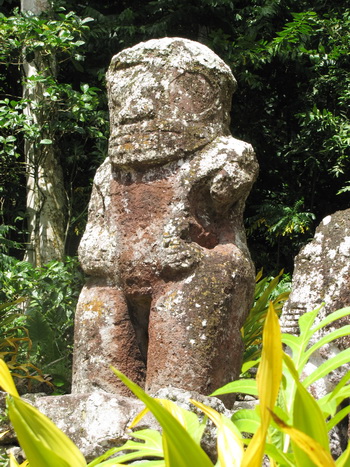
Tiki are scattered all over the island. We stopped along the main road and walked a quarter mile down a dirt road to find this comical "smiling" tiki.
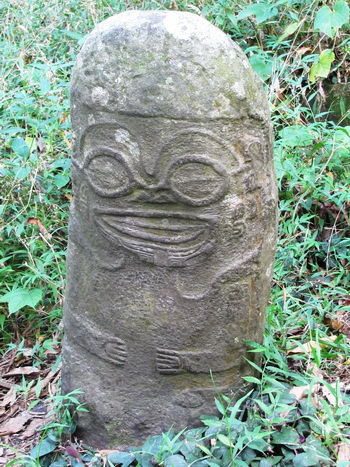
Lunch was served at a modest sized building adjacent to a pension (bed and breakfast). Sloping from the center, the metal roof overhung plywood walls opened to the breeze by large raised shutters all the way around.
Bowls and bowls of delectable local specialties were placed before us. Poisson cru made with red snapper, chunks of tender goat meat in coconut milk and pieces of spicy wild pork served with jasmine rice, breadfruit chips and banana popoi. Popoi is made from fermented breadfruit mixed with manioc flour and has a gooey, glutinous consistency. It was delicious, not at all like the popoi we remembered tasting at touristy Hawaiian luaus that had the taste and texture of Elmer's glue.
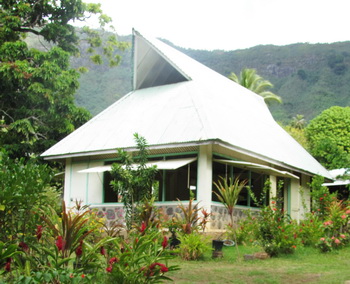
Just beyond the pension was a grave marked by two tiki. Apparently the deceased was some sort of royalty. Strangely, weeds grew in the dirt of the walled tomb.

Each afternoon men paddle their lightweight, high-tech outrigger canoes through the anchorage and out to sea. Some canoes hold just one person while others carry two or six people. They glide quickly and quietly along as the men paddle about 10 strokes on each side.
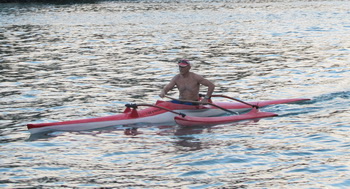
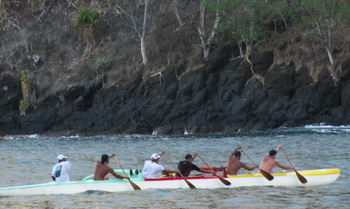
The inhabited shores are littered with older style outrigger canoes. Some are brightly painted and even have engines while others are dilapidated, faded, splintered and look abandoned.
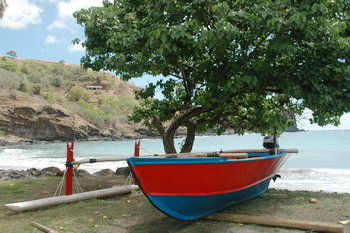
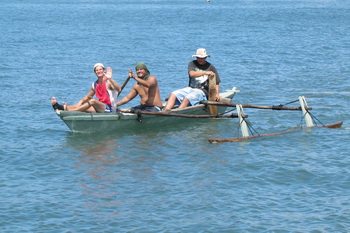
We almost lost our dinghy anchor this morning but a nice young guy named Jack told me that the delivery guys he was with untied one from a dinghy and tied it to theirs. Apparently their anchor got stuck the night before so they tied the line to the the dock. They came in to get it, didn't see it, and saw ours with the same type line. So, they untied ours and took it. Nice. At least we got it back before spending a fortune replacing it in this remote place.

Tomorrow we will sail south to Fatu Hiva. We hear it is the most beautiful island in the Marquesas. Can't wait! Kaoha.
Go to May 2010 Part Three - Fatu Hiva
Go to Photo Gallery - Marquesas